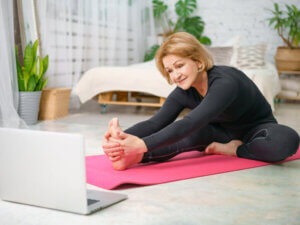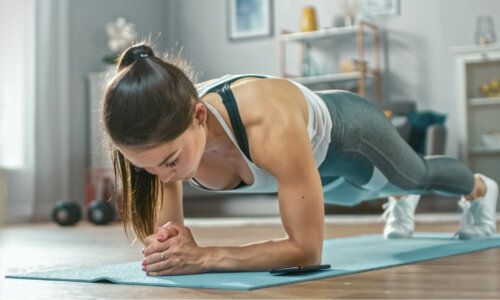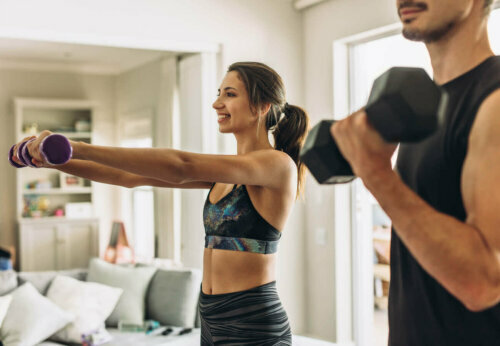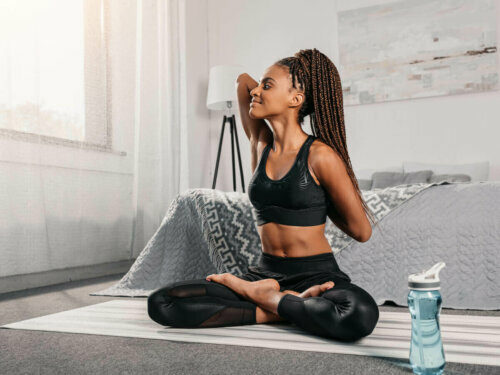Home Gymnastics: Tips to Get You Started

Combining two concepts such as physical exercise and the comfort of your home can be very motivating. This is the case with home gymnastics, a way of doing physical exercise at home. Read this article to learn more about what you can do to stay fit at home!
Home gymnastics isn’t a specific training method but refers to the regular practice of physical activity at home. Below, we’ll delve into this topic and explain some tips to implement it at home.
What is home gymnastics?
Starting from the specific concept of gymnastics, we can say that this is a discipline in charge of developing various physical abilities, among which flexibility and strength stand out, through specific exercises.
It’s worth mentioning that gymnastics is also performed as a sports discipline. However, in this case, we’re only talking about practicing at home.
When talking home gym exercises, there are a number of tips to keep in mind. In the following sections, we’ll note some of the most important ones.
Build a comfortable space
It can be a room, a part of the room, the study, and even a covered patio. The idea is to make the space comfortable so you want to be there. Be sure to include at least one mat, to avoid the hardness of the floor and pain in places such as the cervical or coccyx area.
Do strength exercises
Strength is one of the physical abilities you can improve with gymnastics. For this reason, it’s important to include different strength exercises in your routine. Below, we’ll describe three exercises aimed at your core area, arms, and legs. These are useful to enhance strength through home gymnastics.

Home gymnastics: planks
At first glance, it seems a basic exercise, but when it comes to doing it, it’s one of the most complex exercises that exist. The plank focuses on the isometric effort of the muscle groups in the core area. That way, it strengthens that area of the body.
There are different types, but the most common is the front plank with forearm support. This may be the most suitable option to start in home gymnastics.
Front arm raises
You can do front arm raises and perform this with two dumbbells. This exercise works the deltoid as an agonist muscle – important for increasing arm strength.

On the other hand, it works the biceps and triceps brachii antagonistically, contributing to strength gain in those muscles. To add complexity, you can do the lift laterally and frontally in the same exercise.
Lunges
The last exercise we recommend for gaining strength is the lunge. Indeed, this exercise has many different variations, including ones that involve a jump between repetitions.
Lunges promote power in the quadriceps femoris in an agonistic way, as well as working the posterior thigh in an antagonistic way.
Home gymnastics: flexibility exercises
Talking about gymnastics and not mentioning flexibility is practically a sin. This physical ability is very important, and for this reason, you should include exercise in your routine to enhance it.
Yoga
More than exercise, yoga is a vast discipline that focuses on meditation and flexibility. However, you don’t need to be an expert to practice it, and it gives you both mental and physical benefits.

Stretching
Including a series of stretches for the torso and extremities within your routine promotes increased flexibility. In this sense, it’s important to emphasize that you must be patient and go gradually to avoid injuries that can delay your progress.
Home gymnastics: other ways to exercise
Gymnastics at home isn’t only about implementing sets of physical exercise randomly, but developing a routine you can enjoy and benefit from from the comfort of your home.
Even domestic physical activity – such as housework – can bring health benefits and can be transformed into small gym routines. Your only limit is your imagination, if you put your mind to it, you can do it. Of course, you also have to take into account your physical abilities and increase your activity gradually.
Combining two concepts such as physical exercise and the comfort of your home can be very motivating. This is the case with home gymnastics, a way of doing physical exercise at home. Read this article to learn more about what you can do to stay fit at home!
Home gymnastics isn’t a specific training method but refers to the regular practice of physical activity at home. Below, we’ll delve into this topic and explain some tips to implement it at home.
What is home gymnastics?
Starting from the specific concept of gymnastics, we can say that this is a discipline in charge of developing various physical abilities, among which flexibility and strength stand out, through specific exercises.
It’s worth mentioning that gymnastics is also performed as a sports discipline. However, in this case, we’re only talking about practicing at home.
When talking home gym exercises, there are a number of tips to keep in mind. In the following sections, we’ll note some of the most important ones.
Build a comfortable space
It can be a room, a part of the room, the study, and even a covered patio. The idea is to make the space comfortable so you want to be there. Be sure to include at least one mat, to avoid the hardness of the floor and pain in places such as the cervical or coccyx area.
Do strength exercises
Strength is one of the physical abilities you can improve with gymnastics. For this reason, it’s important to include different strength exercises in your routine. Below, we’ll describe three exercises aimed at your core area, arms, and legs. These are useful to enhance strength through home gymnastics.

Home gymnastics: planks
At first glance, it seems a basic exercise, but when it comes to doing it, it’s one of the most complex exercises that exist. The plank focuses on the isometric effort of the muscle groups in the core area. That way, it strengthens that area of the body.
There are different types, but the most common is the front plank with forearm support. This may be the most suitable option to start in home gymnastics.
Front arm raises
You can do front arm raises and perform this with two dumbbells. This exercise works the deltoid as an agonist muscle – important for increasing arm strength.

On the other hand, it works the biceps and triceps brachii antagonistically, contributing to strength gain in those muscles. To add complexity, you can do the lift laterally and frontally in the same exercise.
Lunges
The last exercise we recommend for gaining strength is the lunge. Indeed, this exercise has many different variations, including ones that involve a jump between repetitions.
Lunges promote power in the quadriceps femoris in an agonistic way, as well as working the posterior thigh in an antagonistic way.
Home gymnastics: flexibility exercises
Talking about gymnastics and not mentioning flexibility is practically a sin. This physical ability is very important, and for this reason, you should include exercise in your routine to enhance it.
Yoga
More than exercise, yoga is a vast discipline that focuses on meditation and flexibility. However, you don’t need to be an expert to practice it, and it gives you both mental and physical benefits.

Stretching
Including a series of stretches for the torso and extremities within your routine promotes increased flexibility. In this sense, it’s important to emphasize that you must be patient and go gradually to avoid injuries that can delay your progress.
Home gymnastics: other ways to exercise
Gymnastics at home isn’t only about implementing sets of physical exercise randomly, but developing a routine you can enjoy and benefit from from the comfort of your home.
Even domestic physical activity – such as housework – can bring health benefits and can be transformed into small gym routines. Your only limit is your imagination, if you put your mind to it, you can do it. Of course, you also have to take into account your physical abilities and increase your activity gradually.
All cited sources were thoroughly reviewed by our team to ensure their quality, reliability, currency, and validity. The bibliography of this article was considered reliable and of academic or scientific accuracy.
- Navarro. F. (1987). La fuerza. Apunts Educación Física.
- Santos, A. B., Arce, M. A. B., Lebre, E., & Ávila-Carvalho, L. (2015). Flexibilidad en gimnasia rítmica: Asimetría funcional en gimnastas júnior Portuguesas. Apunts. Educacion Fisica y Deportes. https://doi.org/10.5672/apunts.2014-0983.es.(2015/2).120.03
- Garfinkel, M., & Schumacher, H. R. (2000). Yoga. Rheumatic Disease Clinics of North America. https://doi.org/10.1016/S0889-857X(05)70126-5
This text is provided for informational purposes only and does not replace consultation with a professional. If in doubt, consult your specialist.








